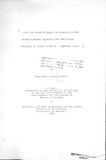| dc.description.abstract | An investigation was carried out for the purpose of determining costs and effectiveness of a nutrition rehabi1itation centre in Siaya District, Western Kenya. For this purpose, the Lwak Family Life Training Centre (FLTC), Siaya District, was chosen. As a first step, records on all children admitted to this centre in 1985 that were available were screened
and relevant information was extracted. Subsequent 1 y , and as far as families could be traced, a visit was paid to each of the children’s
homes. The children as well as their younger siblinqs were examined for their current
nutritional status, and their mothers were subjected to structured interview. The study was retrospective with respect to the criteria of the children’s admission, their courses in the rehabi1itation centre as well as the ultimate outcome of rehabilitation. It was concurrent with respect to mother’s knowledge,
attitude and practice, as well as the nutritional situation of younger siblings. The cost of running the Lwak FI. TC was calculated
from recurrent costs, capital investment costs (amortized) and opportunity costs to mothers, i .e. the amount of money, mothers could have earned had they riot been "immobilized"
at the rehabilitation centre. Effectiveness
of the program was measured by (a) the proportion of children reaching an "acceptable"
nutritional situation (b) their long term
maintenance of the nutritional status,
and (c) the extent of prevention of malnutrition
in younger siblings. Costs of "rehabilitating"
Protein-Fnergy-Ma1nour i shed (PEM ) Pre- School children were determined using both the Lwak- , as well as the World Health Organization’s
(WHO) criteria for "successful" rehabilitation.
The results showed that 413 children had been admitted in that year, 20 of them readmissions.
The majority of children (83* had suffered from either kwashiorkor or marasmus. Altogether 35 deaths occurred among this group during the period of rehabilitation. The cost of running the FLTC in that year amounted to Kshs. 590,247.00. Cost per child admitted was Kshs. 1,429.17. Using the "Lwak criteria" of successful rehabilitation, the costs per child came to Kshs. 3,451.74; according to WHO criteria,
to Kshs. 10,355.21. Of the 320 children
qualifying for follow-up, a further 57 (18*) had died between discharge and the authors’ follow-up. A total of only 129 could be traced, hence, were physically examined. From among these, 71* had maintained their nutritional status, measured in terms of weight-for-age at or above 80* of the NCHS standard. Siblings were found to have a significantly
higher prevalence of stunting 41* than the Nyanza average at 29*. Despite obvious stunting, children had no clinical signs of malnutrition and, in-fact 83* were found to be we 1 1 -nourished i.e. they were at
or above 80% of the standard weiqht - for-age while 52% were above 90% of the weight-for- height median.
Overall, the food consumption of children after discharge had improved suggesting that mothers had indeed changed their feeding practice. | |

